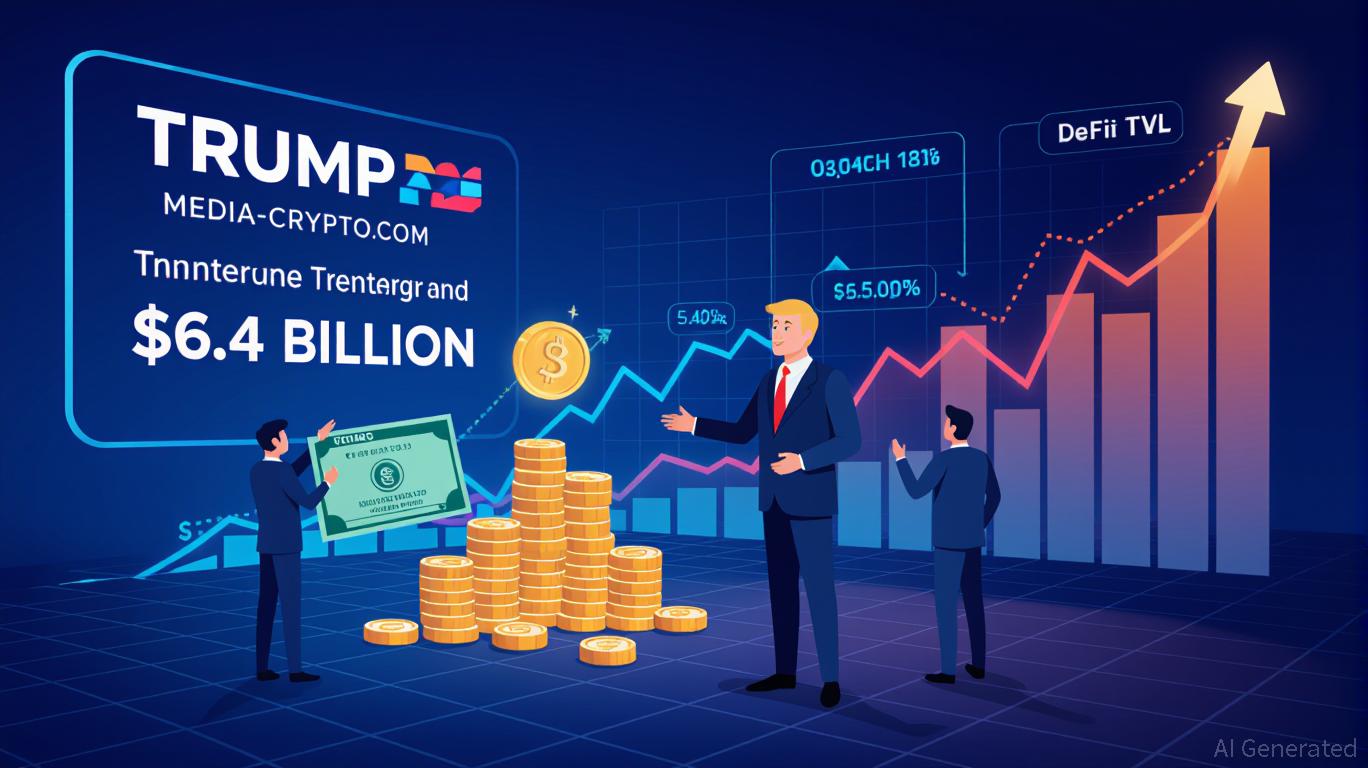The Rise of Ethereum Treasuries: How Decentralized Governance is Reshaping Institutional Capital Efficiency in DeFi
- Ethereum-based DeFi treasuries are reshaping institutional capital strategies through decentralized governance and yield optimization. - DAOs like UkraineDAO ($100M+ raised) and MolochDAO demonstrate trustless, transparent fund management via smart contracts. - Regulatory progress (e.g., ETH ETFs, GENIUS Act) and institutional staking (e.g., BitMine's $150M/year rewards) drive adoption by pension funds and SWFs. - Risks like staking slashing and liquidity discounts prompt diversification strategies and i
In 2025, Ethereum-based decentralized finance (DeFi) treasuries have emerged as a transformative force in institutional investment strategies. No longer confined to speculative trading or speculative staking, these treasuries are redefining how institutions allocate capital, optimize yields, and engage in governance. By leveraging Ethereum's programmable infrastructure, protocols are enabling institutional-grade capital efficiency, active yield generation, and transparent governance models that bridge the gap between traditional finance (TradFi) and decentralized ecosystems.
Decentralized Governance: The New Paradigm for Institutional Trust
Decentralized governance, powered by Ethereum's smart contracts, has become a cornerstone of modern treasury management. Unlike traditional centralized systems, where decisions are made by a small group of executives or boards, Ethereum-based protocols distribute control through token-weighted voting, quadratic funding, and reputation-based systems. This democratization of decision-making ensures transparency, reduces counterparty risk, and aligns incentives across stakeholders.
Case studies like UkraineDAO and MolochDAO exemplify this shift. UkraineDAO, a decentralized autonomous organization (DAO), raised over $100 million in cryptocurrency to support humanitarian efforts in Ukraine, with smart contracts automating fund disbursements and ensuring accountability. Similarly, MolochDAO's reputation-based voting system has allocated millions to open-source projects, proving that decentralized governance can fund public goods without relying on centralized institutions. These models are not just theoretical—they are operational, scalable, and increasingly attractive to institutional investors seeking trustless, auditable systems.
Institutional Strategies: Yield Optimization and Capital Efficiency
Ethereum's unique ability to generate active returns has made it a preferred asset for institutional treasuries. Unlike Bitcoin , which functions primarily as a store of value, Ethereum offers a dual-income model: price appreciation and yield from staking, restaking, and DeFi integration. Publicly traded companies like BitMine Immersion Technologies and SharpLink Gaming have raised billions to accumulate ETH, deploying it into staking operations that generate 3–10% APY. For example, BitMine's $5 billion ETH holdings generate $150 million annually in staking rewards, effectively turning its treasury into a compounding asset.
Institutional investors are also leveraging liquid staking derivatives (e.g., stETH, LsETH) to maintain liquidity while earning yields. These tokens can be traded, used as collateral, or deployed in DeFi protocols for additional returns. Platforms like EigenLayer and Aave's Arc further enhance capital efficiency by enabling restaking and permissioned lending, allowing institutions to maximize exposure without sacrificing flexibility.
Governance participation is another critical component. By staking ETH, institutions gain voting rights on protocol upgrades and access to DAOs, aligning their interests with Ethereum's long-term development. This integration not only enhances governance but also provides a strategic edge in shaping the future of decentralized finance.
Regulatory Clarity and Market Infrastructure: Enablers of Institutional Adoption
Regulatory progress has been a key catalyst for Ethereum's institutional adoption. The approval of Ethereum-based ETFs, such as BlackRock's iShares Ethereum Trust ETF (ETHA), which reached $10 billion in AUM within its first year, has provided a regulated, liquid avenue for institutional capital. In-kind creation and redemption mechanisms have further reduced tax liabilities and improved capital efficiency.
Legislation like the GENIUS Act has also addressed stablecoin oversight, fostering confidence in tokenized assets. These developments are critical for attracting traditional institutional players—pension funds, sovereign wealth funds, and insurance companies—that require legal clarity and operational reliability before committing capital.
Risks and Mitigation: Navigating the DeFi Landscape
Despite the promise, Ethereum treasuries are not without risks. Slashing penalties in native staking, smart contract vulnerabilities in liquid staking protocols, and liquidity constraints during market stress remain challenges. For instance, liquid staking tokens like stETH have occasionally traded at discounts to ETH, exposing investors to temporary value erosion.
To mitigate these risks, institutions are advised to:
1. Diversify staking strategies (e.g., combining native and liquid staking).
2. Utilize institutional-grade staking services (e.g., Figment) for slashing protection and compliance.
3. Monitor regulatory developments, particularly the SEC's stance on staking rewards and token classification.
Investment Outlook: A New Era for Institutional Capital
Ethereum treasuries are no longer a niche experiment—they are a core component of institutional capital management. With 19 publicly traded companies now holding over 2.7 million ETH ($13.2 billion), the trend is accelerating. As Ethereum's upgrades (e.g., Pectra) enhance scalability and user experience, the line between TradFi and DeFi will blur further.
For investors, the key takeaway is clear: Ethereum's programmable infrastructure offers a unique combination of yield generation, governance participation, and capital efficiency. While risks persist, the momentum is undeniable. Institutions that embrace this shift will not only future-proof their treasuries but also gain a strategic foothold in the next era of finance.
In conclusion, Ethereum treasuries represent a paradigm shift in institutional investment. By harnessing decentralized governance and yield-optimized strategies, institutions can transform static reserves into dynamic, income-generating assets. As the ecosystem matures, the winners will be those who act now—before the window of innovation closes.
Disclaimer: The content of this article solely reflects the author's opinion and does not represent the platform in any capacity. This article is not intended to serve as a reference for making investment decisions.
You may also like
CRO’s Sudden Surge Amid Bitcoin’s Rally: Altcoin Momentum and DeFi Recovery in a Bullish Crypto Cycle
- Cronos (CRO) surged 164% weekly amid Bitcoin's $111,000 rally, driven by Trump Media-Crypto.com's $6.4B treasury partnership. - The deal injected institutional liquidity into CRO, expanding its utility in Truth Social payments and boosting TVL by 46.16% in Q3 2025. - Cronos' POS v6 upgrades and $100M Ecosystem Fund position it as a hybrid DeFi-corporate asset, outperforming Bitcoin in percentage gains. - Bitcoin's 59.18% dominance in Q3 2025 highlights a "two-tier" market structure, with altcoins like CR

The High-Stakes Gamble of Celebrity-Backed Memecoins: Why Retail Investors Are Getting Burned
- Celebrity-backed memecoins exploit influencer hype and centralized tokenomics to manipulate prices, leaving retail investors with volatile, utility-less assets. - Insiders hoard 70-94% of supply in projects like YZY and $TRUMP, using liquidity pools and pre-launched allocations to extract millions before crashes. - U.S. regulatory ambiguity enables manipulation via wash trading and sniping, while Canadian authorities demand transparency in promotional arrangements. - Academic studies confirm 82.6% of hig

Horizon: Bridging DeFi and Financial Inclusion Through Consórcio Quotas
- Aave's Horizon project uses blockchain and Chainlink tools to democratize capital access in emerging markets via tokenized real-world assets (RWAs). - Chainlink's ACE and CCIP enable compliance automation and cross-chain interoperability, unlocking $25B in institutional liquidity through structured financing models. - The reimagined Consórcio Quotas model tokenizes cooperative loans with automated KYC/AML checks, expanding financial inclusion while meeting regulatory standards. - Strategic partnerships w

From AI Islands to an Internet of Agents, Here’s Why 2025 Feels Like a Turning Point
